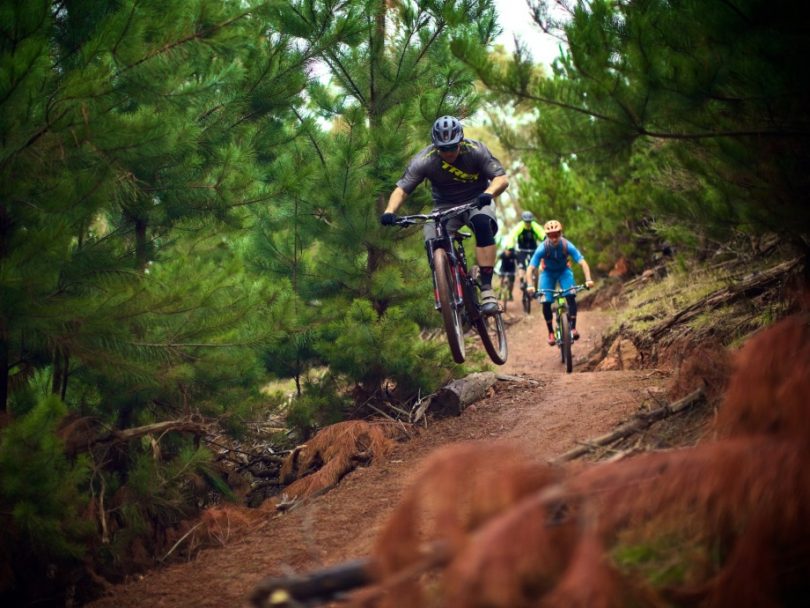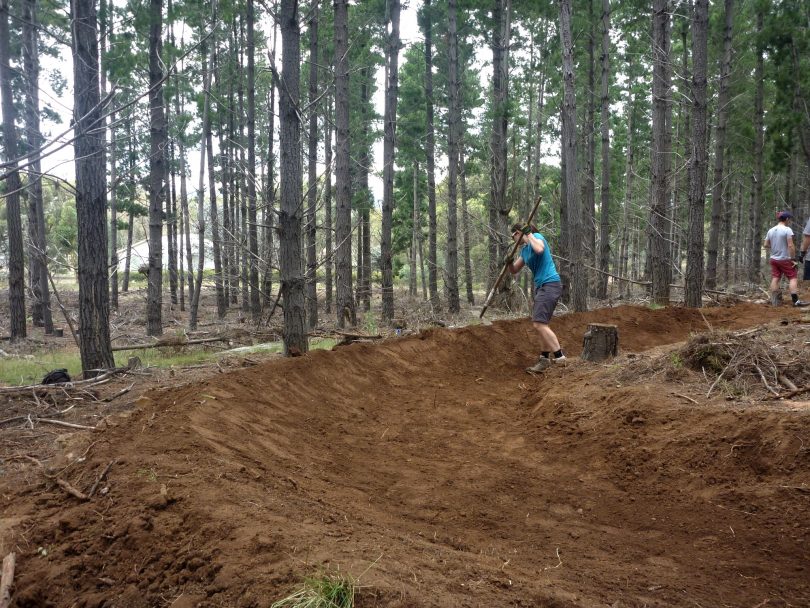
On one of the downhill descents at Majura Pines. Photo: Majura Pines Trails Alliance. Photo: Flow Mountain Bike
The ACT Government could have been accused of not seeing the forest for the trees when it announced a logging schedule that would have destroyed one of Canberra’s biggest tourism and recreational assets.
If not for a bunch of geeky mountain bikers with some community advocacy experience, 80 per cent of Majura Pines would have been cleared in five or six years and 21km of their trails with it.
The volunteer-based Majura Pines Trails Alliance only came into being in 2014 but faced a major test in May when ACT Forests announced that it would begin logging this year, followed by another stage in three or four years and a final stage two or three years after that.
Alliance coordinator Michael Davison said the group recognised Majura Pines was a working forest but it also had strong evidence that it and other areas of the ACT were big attractions for local and interstate mountain bikers.
“Our trail counters and online data showed that about 23 per cent of riders came from interstate so it’s become quite a popular tourism destination,’’ he said.
“We can show what times are the day are most popular, when people are coming, where they’re from and which trails are popular.’’
The Alliance has recorded about 50,000 riders at Majura Pines since it reopened in 2015 but the area is open to all users including horse riders and runners.
Mr Davison said Majura Pines was one of the oldest mountain biking areas in Australia, had hosted Australian championships, 24-hour races, and even had Tour de France winner Cadel Evans racing there.
In October it will host the Canberra Off-Road Cyclists (CORC) 24-hour solo event.
Mr Davison said the Alliance argued successfully to the Government that logging could be done in a more sympathetic way to balance the economic benefits of the timber with that of tourism and the recreational benefits to the community.
“We came to a compromise of a logging schedule over 10 years that would see selected compartments logged from later thus year and replanted, and the next compartments wouldn’t be logged until those first compartments had sufficient regrowth to provide some shade and canopy,’’ he said.
The work would also protect the trails as much as possible
“It was significant win for us and the community that we now have the Government recognise that there is more to our forests than just the value of the timber,’’ he said.
It was also a successful exercise in the community engaging and working with government to achieve a mutually beneficial outcome.
“With the sequential logging program, we’ll have a completely new forest. It’ll be young but we’ll have regrowth and it means we’ll be set up as a recreation area for the next 30 to 40 years,” Mr Davison said.

Alliance volunteers at a trail day in the forest. Photo: Majura Pines Trails Alliance.
The Alliance has always worked with Parks and Conservation Services, which had the first trails professionally built in Majura Pines but now aids the volunteer group with tools and equipment to build and maintain trails.
The most challenging trails are the most popular but a wide variety keep all levels happy.
“There are a couple of downhill trails at either ends of the Pines that have had 30,000 riders over two years,’’ Mr Davison said.
“But the beginners area of Majura Road is really good for families, anyone can ride that. I often see parents and kids there. That’s what it’s all about to get the kids out there. Then there are the steeper trails up Mt Majura, the further you go up the harder it gets. You can improve and develop.’’

Alliance volunteers at a trail day in the forest. Photo: Majura Pines Trails Alliance.
All the Alliance’s trails are hand-built using rakes, hoes, shovels and mattocks, with an average of 15 to 20 volunteers pitching in, depending how “sexy” the trail is.
There are trail days every second or third week over the warmer months and the Alliance is always looking for more volunteers.
“Some give us just one morning a year and it can make a huge difference,” Mr Davison said.
The Alliance has a steering group of eight with about 140 volunteers who have helped build trails over the past three years.
There are no membership or joining fees, with the Alliance relying on donations from individuals, clubs, CORC, and local businesses such as IGA Hackett, and Monkey Wrench.
Mr Davison said those who can’t volunteer often make a donation, which can be made on the Majura Pines Trails Alliance website http://www.majurapines.org/
More information can also be found at Facebook: https://www.facebook.com/majurapines












